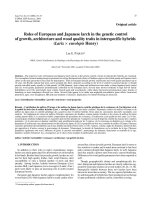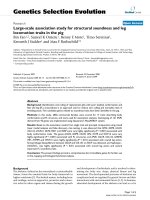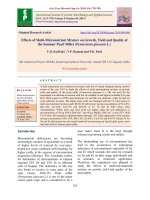Association study of grain yield and nutritional quality traits in pearl millet [Pennisetum glaucum (L.) R. Br.] hybrids
Bạn đang xem bản rút gọn của tài liệu. Xem và tải ngay bản đầy đủ của tài liệu tại đây (148.28 KB, 5 trang )
Int.J.Curr.Microbiol.App.Sci (2018) 7(10): 2035-2039
International Journal of Current Microbiology and Applied Sciences
ISSN: 2319-7706 Volume 7 Number 10 (2018)
Journal homepage:
Original Research Article
/>
Association Study of Grain Yield and Nutritional Quality Traits in Pearl
Millet [Pennisetum glaucum (L.) R. Br.] Hybrids
K. Subbulakshmi1*, P. Sumathi2 and C. Babu3
1
Centre for Plant Breeding and Genetics, 2Department of Millets, 3Department of Forage
crops, TNAU, Coimbatore-3, Tamil Nadu, India
*Corresponding author
ABSTRACT
Keywords
Biofortification,
Correlation, Path
analysis, Grain yield,
Pearl millet
Article Info
Accepted:
15 September 2018
Available Online:
10 October 2018
Genetics of quality parameters and their associations with grain yield and its component
traits have a direct bearing on devising effective strategies for breeding biofortified crop
cultivars. A newly developed 54 hybrids of pearl millet showed large genetic variability
for yield and nutritional traits. Correlation studies revealed that single plant yield has
positive significant correlation with the agronomic traits viz., plant height, number of
productive tillers, test weight, single head grain weight and quality traits viz., crude fiber,
beta carotene and iron whereas the trait days to fifty per cent flowering alone was recorded
negatively significant correlation with single plant yield. It is therefore inferred that simple
selection will be effective against positively correlated characters. There is no correlation
between grain zinc and yield which suggests that, there is possibility of selection for
increased grain zinc content without reducing the grain yield. Maximum direct effect on
grain yield was contributed by single head grain weight which is positive and highly
significant followed by single head grain weight and number of productive tillers. Results
of this present study put forward the way to the development of biofortified cultivars.
Introduction
Pearl millet is an important coarse grain cereal
adapted to the arid and semi-arid tropical areas
of Africa and the Indian subcontinent with
200-800 mm annual rainfall, where no other
cereal crop can be grown successfully. India is
one of the largest producers in Asia. Pearl
millet [Pennisetum glaucum (L.) R. Br.]
belongs to the family Poaceae (graminae) and
genus Pennisetum. It is a highly crosspollinated crop with protogynous flowering
and wind borne pollination mechanism, which
fulfils the essential biological requirement for
hybrid development. Pearl millet remains as
the major source of nutritious food for poorest
people in semi-arid regions of tropical and
sub-tropical countries. The ultimate aim of the
plant breeding programs is improvement of
productivity which measured in terms of yield
per unit area. The complex nature of yield is
associated with yield contributing characters
which are interrelated among them. Such
interdependence of the contributory features
often affects their direct relationship with
yield, thereby making correlation coefficients
2035
Int.J.Curr.Microbiol.App.Sci (2018) 7(10): 2035-2039
unpredictable as selection indices (Khairwal et
al., 1999).
Materials and Methods
The trial was carried out in randomized block
design (RBD) with three replications under the
prevailing environmental conditions at
department of millets, TNAU, Coimbatore,
lies between 11° North latitude and 77° East
longitude. Each genotype was represented by
3 rows of 5 m length with 45 cm between
rows and 15 cm between plants. Till the
harvesting, all the recommended inputs and
cultural
practices
including
fertilizer,
irrigation, hoeing and pest control were
followed. The genetic material used in this
study was received from Department of
Millets, TNAU. A total of fifty four newly
developed hybrids were utilized for the
present study. Variability analysis was carried
out for the newly developed fifty four hybrids
for thirteen characters which include eight
biometric and five quality traits viz., days to
fifty per cent flowering, plant height, number
of productive tillers/plant, earhead length,
earhead girth, test weight, single head grain
weight, single plant yield, crude protein, crude
fiber, beta carotene, iron and zinc. The
observation was recorded for nutritional traits
viz., protein content (N x 6.25) using
microkjeldahl method (Jackson 1973). The
zinc and iron contents were determined by
using Atomic absorption spectrophotometer
(Humphries 1956) at the department of
environmental sciences, TNAU, Coimbatore.
Crude protein and crude fiber content were
estimated at the Department of Forage crops,
Centre for Plant Breeding and Genetics. All
the statistical analysis was done by using
TNAUSTAT statistical software.
Results and Discussion
Results of phenotypic and genotypic
correlation for yield and nutritional traits were
presented in the table 1. Phenotypic
correlation was higher than genotypic
correlation for all the characters studied,
which shows that environment also plays an
important roles for the trait expression.
The traits plant height (0.2379), number of
productive tillers per plant (0.6308), test
weight (0.8792) and single head grain weight
(0.8401)
were
significantly
positive
correlation with single plant yield. These
results were conformity with the earlier results
of Hepziba et al., (1993), Tomer et al., (1995),
Poongodi and Palanisamy (1995), Anarase et
al., (2001), Khan et al., (2002) and Govindaraj
et al., (2009).
In the case of nutritional traits viz., crude fiber
(0.2343), beta carotene (0.5065) and iron
(0.4107) content also recorded positively
significant association with single plant yield
and it can be improved without harming the
yield. Whereas the character days to fifty per
cent
flowering
(-0.2760)
recorded
significantly negative correlation with single
plant yield. This result has conformity with the
previous works of Govil et al., (1982), Izge et
al., (2006) and Vetriventhan et al., (2007).
The quality traits viz., crude protein and zinc
had no correlation with single plant yield and
these findings have similarity with Arya et al.,
(2009). Contrast results also reported by (Virk,
1988 and Choudhary, 2003) as negative
significant correlation of grain yield with
quality parameters.
In the case of inter correlation resulted that,
association between the traits plant height,
earhead length, single head grain weight,
crude fibre, beta carotene and iron were
positively significant and which indicates that
selection for these traits in the early generation
will work out. The results were in agreement
with findings of Azhaguvel (1997) and Latha
and Shanmugasundaram (1998).
2036
Int.J.Curr.Microbiol.App.Sci (2018) 7(10): 2035-2039
Table.1 Genotypic correlation analysis for thirteen traits of hybrids
DFF
DFF
PH
NPT
EHL
EHG
TW
SHW
CP
CF
BC
FE
ZN
SPY
-0.1175
-0.2239*
0.1933
0.0202
-0.2797*
-0.1485
0.0669
-0.1531
-0.1506
-0.2917*
-0.0613
-0.2616*
PH
NPT
EHL
EHG
TW
SHW
CP
CF
BC
FE
ZN
SPY
-0.1286
-0.2827*
-0.3129**
0.1210
0.6929**
-0.4809**
0.0126
0.3814**
-0.1796
0.3557**
-0.2963**
0.0917
0.5792**
0.1128
0.0642
-0.1661
0.4756**
0.1423
0.5482**
0.1534
0.6902**
0.0683
-0.1789
0.0366
-0.1230
-0.2571*
0.0033
-0.0326
-0.1605
0.2652*
0.0285
0.2379*
0.0166
0.2971**
0.2392*
-0.0973
-0.1552
0.4192**
0.2470*
0.3318**
0.2623*
0.4771**
0.3835**
0.0240
0.1867
-0.3469**
0.2905*
0.0980
0.1376
0.1808
0.3301**
0.4078**
0.0389
0.1207
0.2548*
-0.0773
0.1145
-0.0949
0.1762
0.0975
0.1351
0.2264*
0.0685
0.0952
0.0946
0.3609**
-0.2760*
0.2379*
0.6308**
0.1985
0.0950
0.8792**
0.8401**
0.0037
0.2343*
0.5065**
0.4107**
0.1496
-0.2628*
0.6135**
0.3324**
0.0858
0.4436**
-0.1733
0.2569*
0.4069**
0.2496*
0.0931
0.2270*
-0.3514**
-0.1383
0.4943**
-0.0344
0.0301
-0.0265
0.1957
0.0491
-0.0565
0.5575**
0.3073**
0.1046
0.4691**
-0.1102
0.2080
0.2966**
0.1060
0.1295
0.1827
0.0797
0.1305
-0.2190*
0.0037
0.2305*
0.1322
0.0664
0.0905
0.6360**
0.0016
0.2926*
0.4622**
0.2822*
0.1278
0.8685**
-0.0313
0.2282*
0.3551**
0.3527**
0.1864
0.7745**
-0.0964
0.0233
0.0295
0.0622
0.0036
0.1838
0.1081
0.0940
0.2295*
0.2282*
0.0951
0.4893**
0.3201**
0.3588**
0.1389
** Significant at 1 per cent level; * Significant at 5 per cent level. Upper diagonal indicates genotypic correlation and down diagonal indicates phenotypic
correlation
DFF: Days to fifty per cent flowering, PH: plant height, NPT: Number of productive tillers, EHL: Ear head length, EHG: Ear head girth, TW: Test weight, SWG:
Single head grain weight, CP: Crude protein, CF: Crude fibre, BC: Beta carotene, FE: Iron, ZN: Zinc, SPY: Single plant yield
Table.2 Genotypic path analysis with dependent variables
DFF
PH
NPT
EHL
EHG
TW
SHW
CP
CF
BC
FE
ZN
DFF
PH
NPT
EHL
EHG
TW
SHW
CP
CF
BC
FE
ZN
0.0286
-0.0037
-0.0081
0.0035
0.0004
-0.0085
-0.0047
0.0020
-0.0046
-0.0044
-0.0099
-0.0022
-0.0017
0.0132
-0.0041
0.0092
0.0050
0.0012
0.0063
-0.0024
0.0035
0.0055
0.0038
0.0015
-0.1384
-0.1532
0.4897
-0.2355
-0.0879
0.2836
0.0697
0.0179
-0.0140
0.1209
0.0480
-0.0464
0.0016
0.0090
-0.0062
0.0130
0.0046
0.0015
0.0071
-0.0016
0.0031
0.0043
0.0018
0.0023
0.0007
0.0201
-0.0095
0.0188
0.0528
0.0034
0.0081
-0.0136
0.0009
0.0138
0.0095
0.0051
-0.0327
0.0101
0.0639
0.0124
0.0071
0.1103
0.0761
0.0004
0.0328
0.0526
0.0364
0.0149
-0.1043
0.2986
0.0893
0.3443
0.0963
0.4335
0.6280
-0.0205
0.1502
0.2409
0.2561
0.1422
0.0016
-0.0041
0.0008
-0.0028
-0.0059
0.0001
-0.0007
0.0229
-0.0022
0.0006
0.0009
0.0016
-0.0079
0.0131
-0.0014
0.0117
0.0008
0.0146
0.0118
-0.0048
0.0493
0.0092
0.0059
0.0047
-0.0080
0.0216
0.0127
0.0171
0.0135
0.0246
0.0198
0.0012
0.0096
0.0516
0.0131
0.0049
-0.0149
0.0125
0.0042
0.0059
0.0078
0.0142
0.0175
0.0017
0.0052
0.0110
0.0430
0.0155
-0.0004
0.0006
-0.0005
0.0010
0.0005
0.0007
0.0012
0.0004
0.0005
0.0005
0.0020
0.0055
Genotypic
correlation
-0.2760*
0.2379*
0.6308**
0.1985
0.0950
0.8792**
0.8401**
0.0037
0.2343*
0.5065**
0.4107**
0.1496
** Significant at 1 per cent level; * Significant at 5 per cent level. Residual effect = 0.218
DFF: Days to fifty per cent flowering, PH: plant height, NPT: Number of productive tillers, EHL: Ear head length, EHG: Ear head girth, TW: Test weight, SWG:
Single head grain weight, CP: Crude protein, CF: Crude fibre, BC: Beta carotene, FE: Iron, ZN: Zinc, SPY: Single plant yield
2037
Int.J.Curr.Microbiol.App.Sci (2018) 7(10): 2035-2039
Results of path coefficient analysis are
presented in the table 2. The correlation study
measures the relationship between pairs of
traits. Whereas, dependent traits are an
interaction
with
mutually
associated
components. The path analysis takes into
account the cause and effect relationship
between the variables by partitioning the
association into direct and indirect effects
through other independent variables. The
direct and indirect associations on grain yield
were carried out using coefficient of all the
traits with grain yield plant per plant. In this
study, the response variable grain yield and
other twelve variables, path analysis was
possible to categorize plant characteristics
according to magnitude of their effect on
grain yield.
The path analysis revealed that, plant height
had moderate positive direct effect followed
by crude fiber on grain yield. High positive
effect was observed for the traits viz., number
of productive tillers per plant and single head
grain weight its indirect effect through other
observed characters were also positive. It was
confirmed by Hepziba et al., (1993) and
Poongodi and Palanisamy (1995) for the
influence of traits like number of productive
tillers. Similarly, days to fifty per cent
flowering had positive direct effect, but had
negative association with grain yield per
plant.
Low positive effect was obtained for the trait
test weight which also had positive and highly
significant association with single plant yield.
From the present study point toward that an
ideal pearl millet plant should have significant
number of productive tillers, test weight and
single head grain weight since they expressed
significant correlation with maximum direct
effect on grain yield per plant. Selection
based on these traits may be helpful in
development
of
efficient
breeding
programme.
References
Anarase, S.A., Ugale, S.D. and Shinde, G.C.
(2001). Correlation and path-coefficient
analysis in pearl millet. The Andhra
Agric. J. 48:33-36.
Arya R.K., H.P. Yadav, Desh Raj and Ashok
Kumar Yadav. (2009). Correlation
studies of white and grey grain colour
hybrids in pearl millet. Agric. Sci.
Digest, 29(2).
Azhaguvel, P. (1997). Morphological and
molecular
characterization
of
cytosteriles in pearl millet (Pennisetum
glaucum (L.) R. Br.). M.Sc. (Ag.)
Thesis, Tamil Nadu Agric. Univ.,
Coimbatore.
Chaudhry, M. H., Chaudhry, M.H., S.G.
Mahboob, S.M. Saleem and Usman, S.
(2003).
Correlation
and
path
coefficients analysis in pearl millet
(Pennisetum americanum L.). Pakistan J
Biol. Sci., 6: 597 -600.
Govil, J.N., S.C. Pokhriyal and B.R. Murty.
(1982). Full-sib and reciprocal recurrent
selection in relation to pearl millet
improvement. Theor. Appl. Genet. 62,
25-30.
Govindaraj, M., B. Selvi and S. Rajarathinam.
(2009). Correlationg studies for grain
yield components and nutritional quality
traits in pearl millet germplasm. World
J. Agric. Sci. 5 (6): 686-689.
Hepziba, J.J., R. Saraswathi, M.T. Mani, R.
Rajasekaran and S. Palanisamy, 1993.
Genetic variability, association among
metric traits and path co-efficient
analysis in pearl millet. Annals Agric.
Res., 14(3): 282-285
Khairwal, I.S., K.N. Rai, D.J. Andrews and G.
Harinarayana. (1999). Pearl millet
Breeding. Oxford and IBH Pub. Co,
New Delhi.
Khan, F.A.K., and K. Sukumar. (2002).
Genotypic and Phenotypic correlation
and path analysis in napier grass
2038
Int.J.Curr.Microbiol.App.Sci (2018) 7(10): 2035-2039
Pennisetum purpureum (K) Schum,
germplasm. Madras Agric. J. 89 (13):164-166.
Latha, R. and Shanmugasundaram, P. (1998).
Combining ability studies involving
new male sterile lines in pearl millet.
Madras Agric. J., 85(3, 4): 160-163.
Poongodi, J.L. and S. Palanisamy. (1995).
Correlation and path analysis in pearl
millet (Pennisetum glaucum). Madras
Agric. J., 82: 98-100.
Tomer, N.S., Kushawaha, V.S. and Singh,
G.P. (1995). Association and path
analysis of elite genotypes of pearl
millet (Pennisetum typhoides S and H.).
J. Soil Crops, 5(2): 117- 120.
Virk, D.S. (1988) Biometrical analysis in
pearl milled - A Veviewd Crop Improv
15:1-29.
How to cite this article:
Subbulakshmi, K., P. Sumathi and Babu, C. 2018. Association Study of Grain Yield and
Nutritional Quality Traits in Pearl Millet [Pennisetum glaucum (L.) R. Br.] Hybrids.
Int.J.Curr.Microbiol.App.Sci. 7(10): 2035-2039. doi: />
2039



![Studies on correlation and path analysis for grain yield and quality components in foxtail millet [Setaria italica (L.) Beauv.]](https://media.store123doc.com/images/document/2020_01/09/medium_dyd1578574836.jpg)

![Genetic parameters for grain yield and nutritional quality traits in foxtail millet [Setaria italica (L.) Beauv.]](https://media.store123doc.com/images/document/2020_01/13/medium_tvq1578927783.jpg)
![Genetic analysis for micronutrients and grain yield in relation to diverse sources of cytoplasm in pearl millet [Pennisetum glaucum (L.) R. Br.]](https://media.store123doc.com/images/document/2020_01/13/medium_ion1578932058.jpg)
![Response of pearl millet [Pennisetum glaucum L. (R. Br.)] to integrated nitrogen management](https://media.store123doc.com/images/document/2020_01/14/medium_jyr1578949761.jpg)
![Production of interspecific hybrids between pearl millet [Pennisetum glaucum (L.) R. Br.] × Napier Grass [Pennisetum purpureum (K.) Schum] and their characterization](https://media.store123doc.com/images/document/2020_01/14/medium_rod1578988436.jpg)
![Studies on combining ability for yield and its component traits in rabi sorghum [Sorghum bicolor (L.) Moench]](https://media.store123doc.com/images/document/2020_03/02/medium_mzw1583124925.jpg)